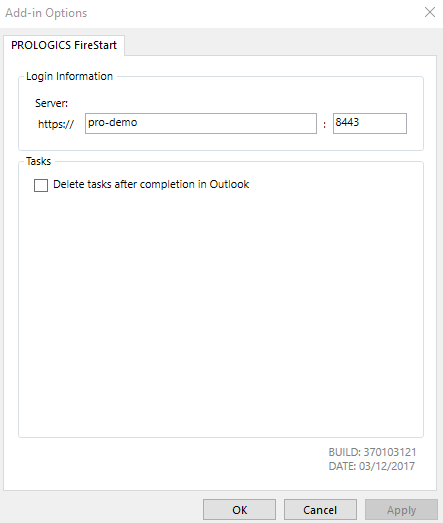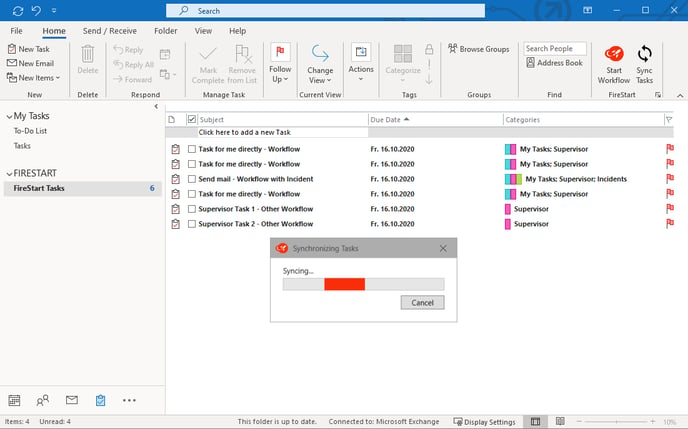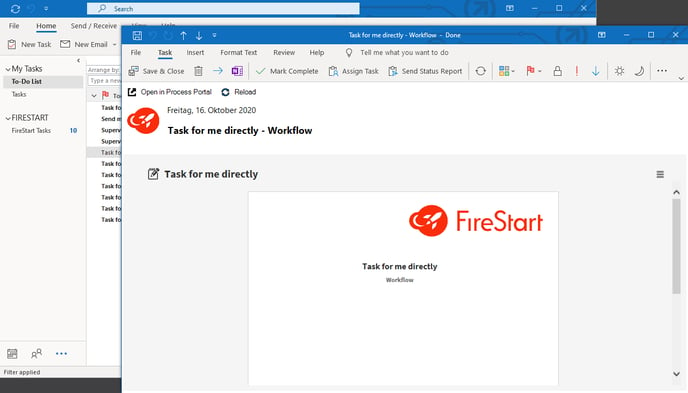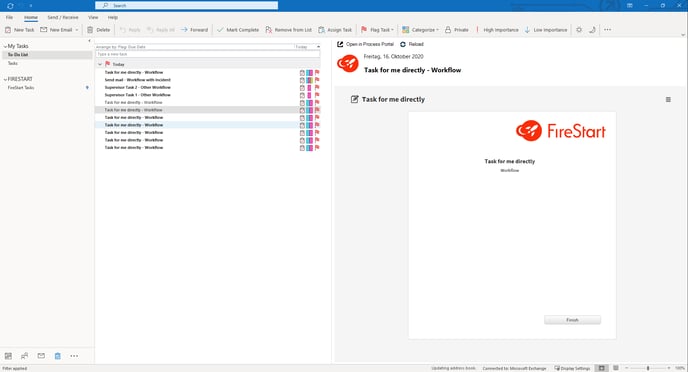The Outlook Add-In is useful for executing workflows. It displays tasks sent from a workflow execution directly in Outlook, so you don't have to navigate to the Process Portal. Moreover, you don't have to log in to the FireStart Client because you can start workflows directly from the Add-In, therefore you can start a workflow from anywhere.
Installation of the Outlook Add-In
You can find the files for installation on the server here:
<FireStartInstallDir>\FireStart Resources\Downloads\FireStart Outlook Add-In.
1. FireStart_Outlook_Add-In_x64.msi/FireStart_Outlook_Add-In_x86.msi
Using this file to install the Outlook Add-In works without any additional configuration.



The Add-In is automatically integrated into Outlook after installation.
2. FireStart.Outlook.AddIn.vsto
For the installation via the .vsto file, there are also two versions of the vsto file available (x64, x86). Installing the Outlook Add-In with this file leads to an interruption of the installation because it doesn't trust the source (FireStart GmbH). In this case, simply install the PROLOGICS IT GmbH.cer (same folder as the installation files) and the installation can carry on.
Configuration of the Outlook Add-In
In case you want to use the Add-In just for displaying tasks, then there is no further configuration required. But if you want to have the possibility to start workflows then there is one step left to configure. There are again two different ways to do the configuration for starting workflows over the Outlook Add-In.
1. Configuration in Outlook
You can configure this in Outlook itself using two different dialogs. For the first and easier one, you only have to navigate to the Start tab and click on the small icon in the FireStart section. In the opened dialog you just have to enter the server the FireStart Client runs on and then Close the dialog.

The second way to get to those settings is via Outlook Options. Under Add-Ins you see an Add-In Options button, click on it and a dialog opens. Navigate to the FireStart Outlook Add-In tab and enter the server, with clicking on the Apply button you save it. Click OK to close the dialog.


2. Configuration File
This version might be a bit more functional because you as the administrator don't have to enter the server in every Outlook Add-In you install. With the configuration file, you simply have to copy the file to a specific path and the FireStart server is configured. To get the configuration file you need to configure the Add-In with the method mentioned above at least once. The configuration file then is generated so you don't have to write it yourself. The generated configuration file can be found in path %localappdata%\PROLOGICS\PROLOGICS FireStart Outlook Add-In. Now you just need to copy the file to the same path at every client who wants to install the Outlook Add-In. After that, every user can start a workflow over the Outlook Add-In.
Content of configuration file prologics_firestart_outlook_addin.config:
<?xml version="1.0" encoding="utf-8"?>
<configuration>
<appSettings>
<add key="Server" value="firestart-server.domain.local" />
<add key="Port" value="443" />
<add key="DeleteCompletedTasks" value="True" />
<add key="TaskFolderName" value="FireStart Tasks" />
<add key="FolderGroupName" value="FIRESTART" />
<add key="HideRibbon" value="False" />
</appSettings>
</configuration>
Using the Add-In
All user assigned tasks (regardless if they were deployed via Mail Portal or not) get shown in the Outlook Task View. When clicking the “FireStart Tasks” folder or the “Sync Tasks” button in the ribbon, the Outlook view get’s synchronized with the FireStart server. Tasks get categories depending on User in Charge (My Tasks), the task as supervisor (Supervisor) or Activity Failed task (Incident).

Double-clicking on the task opens it on a separate window:

Also, a preview pant on the right side (like in the mail view) can be show:

Note: Due to technical limitations within Outlook, the tab key cannot be used properly to jump between the different input fields in a task.
To learn how to start a workflow, please read the Workflow Automation help articles, and in particular the topic Deploy and Start a Workflow.
